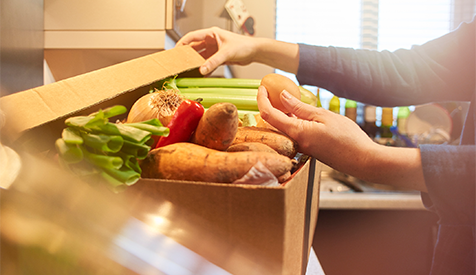Will micro-fulfilment transform e-grocery profitability?
The grocery business is having its moment. Retailers are adapting to the challenge of online faster than many can keep up with. Ocado’s pivot into an e-commerce platform provider and Walmart’s continued heavy investment into digital are just two examples of how the market is responding.
As retailers are forced to consider existing logistics strategies in response to customer demands and fierce competition, new innovative fulfilment models are being explored to address the need to provide fast, cost effective and accurate e-grocery delivery services. The question is if these new operating models can provide an answer to the profitability challenge of e-groceries?
Online is continuing to outperform other grocery channels and there is a renewed focus on how retailers can effectively balance growth with profitability. E-grocery is fundamentally a high volume, low margin logistics business. Its cost base is driven by order fulfilment and last mile delivery which accounts for over 60% of total cost and 80% of variable cost. Choosing the right operating model to most effectively pick and deliver orders is the key that unlocks better profitability and competitive customer propositions.
What is the trade-off with existing e-grocery fulfilment models?
Meeting customer expectations around product choice, availability and delivery without compromising on quality or price is challenging. For traditional bricks-and-mortar retailers, a pick from store model helps to leverage existing property networks, supply chains and management to better utilise existing assets and, being located closer to customers, reduce last-mile costs. However, as volumes rise the benefits are impacted by the manual processes deployed in store which increase the risk of inaccuracy, product damage and impact on the store’s regular shoppers.
Large automated centralised fulfilment models on the other hand provide a method to reduce picking cost and errors whilst improving customer metrics (availability, range and quality). However, this option lacks flexibility and requires significant upfront investment as well as scale to achieve the lower operating cost. Being situated outside of urban areas also results in longer delivery distances from customers, increasing delivery costs.
This is now changing. In the last two years solutions have appeared on the market which can give the benefits of automation at much smaller scale and much lower cost. These new fulfilment operations enable automation to be effectively applied at a store level, combining efficient picking with more local last-mile delivery in what is being referred to as micro-fulfilment.
What is micro-fulfilment and how does it work?
Micro-fulfilment is the term used to describe automated small-scale fulfilment centres that are deployed inside of urban areas, which are naturally closer to customer homes. They’re small enough to be installed at the back of supermarkets, helping to convert unprofitable slow-moving space into profit centres.
Micro-fulfilment potentially offers a winning formula of high-density automated item-picking (reduced picking costs) and in-city deployment (lower delivery costs), providing an opportunity for retailers to reduce total logistics costs whilst improving quality and offering a good product range and short lead-times.
Micro-fulfillment vendors are currently claiming a throughput of 3,500 orders per week (60 items per order) within a 1,000 m2 space, handling 10,000 to 12,000 SKUs across three temperature regimes at a productivity of between 130–170 units per hour. Our modelling suggests the saving would be £3 – £5 per order when compared to a traditional pick from store model. If this was to be achieved it would be truly transformative for e-grocery profitability.
Who are the players disrupting e-grocery fulfilment?
Three new start-ups that are making headway in this space are: CommonSense, Alert Innovation and Takeoff. All three have developed solutions that provide efficient, low footprint picking technology that can be quickly installed within existing underutilised space.
- Alert Innovation has developed an automated storage and retrieval system called Alphabot specifically designed for online grocery and is currently trialling its solution in a pilot program with Walmart. Its first facility is a 20,000-square foot extension of an existing superstore in New Hampshire and is planned to launch early 2019.
- Takeoff, rather than building automation technology in-house, has partnered with Knapp, an established goods to person hardware provider. They are using Knapp’s existing shuttle technology and combining it with an end-to-end e-grocery platform. Using this proven modular technology, they are looking to quickly scale helping retailers to rapidly develop profitable e-grocery offerings at a store level. They have recently announced their first U.S. partnership with the Florida-based grocer, Sedano’s Supermarkets and plan to open their first ‘robotics supermarket’ later this year.
- Israel’s CommonSense Robotics, like Alert Innovation has developed its own in-house robotics technology. Unlike other models, the solution is not integrated to stores but runs as an independent service that is fully operated end-to-end by CommonSense. With plans to build an independent integrated network of micro-fulfilment centres they will be announcing their new U.S. partnership over the next few months.
What impact could this have on e-grocery?
On a fully costed basis, online grocery has a net-net margin between +2% (at best) and -10%. Taking £3 – £5 per order out of the logistics costs could transform this margin to be much closer to store only grocery of between 2% and 5%. Therefore, this would make the growth of online much less profit dilutive.
There are also potential additional benefits to introducing a back-of-store order fulfilment capability. Micro-fulfilment changes the sales / sq. ft. equation allowing back-of-store space to more effectively compete with merchandisable store fronts. As a result, it could help transform the in-store experience as we know it. Retailers instead, for example, might focus on fresh and experiential food offerings that would satisfy customers’ unique and ever-changing needs.
FIND OUT MORE about Javelin Group’s Operations service line.
